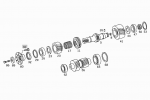Geo.Lander
Well-known member
Front and rear axle ratios are always the same. What is printed on the labels on front and rear axles? What does the Mercedes Benz parts catalog show when you check your VIN? What are the SA codes starting with A..?
According to the VIN my axles are mixed, fast on the back, medium on the front.. with my limited understanding on the low level workings of differentials I can imagine a mixed axle ratio can either be compensated for in the hubs and/or plays a part of rear wheel drive bias (unless there is a slip in the rear wheel then they pickup more torque from the center diff). I have not also asked this question on LN2 forum.
AL 3/8 D-4,7 - FRONT AXLE, RATIO 39:8
HL 4/29 D-9,2 - REAR AXLE, RATIO 43:10
Last edited:


